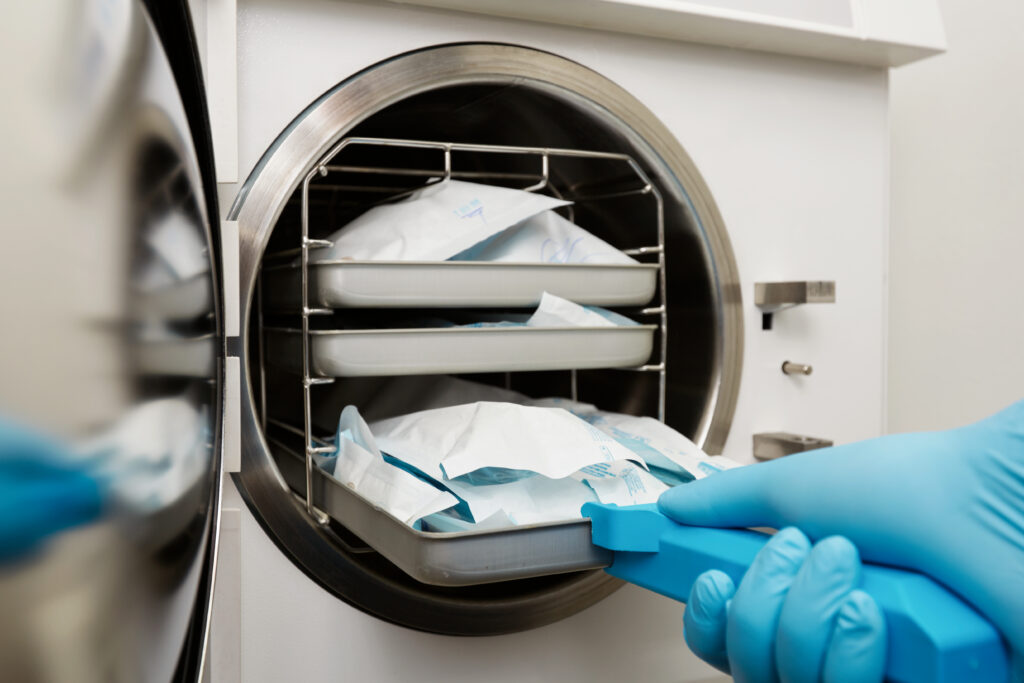In dentistry, sterilization isn’t just a behind-the-scene procedure—it’s the backbone of patient safety and clinical excellence. Proper infection control protects everyone who walks into your practice, from the front desk to the operatory. As standards evolve and expectations rise, every dental clinic must prioritize best practices in sterilization to remain both compliant and trusted.
Whether you’re starting a new practice or updating protocols, this guide breaks down the essential sterilization strategies for 2025 and beyond.
- Understanding the Importance of Sterilization
– Sterilization eliminate all forms of microbial life—including bacteria, viruses, fungi, and spores—from instruments and surfaces. In a dental setting where tools come into contact with blood, saliva, and mucous membranes, thorough sterilization is critical to prevent cross-contamination and healthcare associated and healthcare-associated infections (HAIs) - Follow the Spaulding Classification
The Spaulding Classification system helps dental teams determine how to properly disinfect and sterilize different types of instruments:
– Critical instruments (eg. scalers, forceps) must be sterilized
– Semi-critical instruments (eg. mirrors, impression trays) may require high-level disinfection or sterilization.
– Non-critical instruments (eg. blood pressure cuffs) need intermediate or low-level disinfection.
✅ Tip: Categorize your instruments and label storage areas accordingly to avoid confusion. - The Sterilization Workflow: Step-by-step
To ensure consistency, every clinic should follow a standardized sterilization workflow:
1. Receiving and Cleaning
– Instruments should be manually or ultrasonically cleaned immediately after use to remove debris
2. Packing
– Once dry, tools should be placed in sterilization pouches with chemical indicators inside
3. Sterilization
– Use an autoclave (steam under pressure) or other approved methods like dry heat or chemical vapor sterilizers
4. Storage
– Sterile instruments should be kept in a clean, dry, and designated area away from contamination sources
5. Documentation
– Maintain logs of sterilizer cycles, including date, load number, cycle parameters, and operator initials. - Monitor Your Sterilization Process
Monitoring is essential to ensure your equipment is functioning properly and that sterilization is effective:
– Mechanical Monitoring: Record time, temperature, and pressure for each cycle.
– Chemical Monitoring: Use internal and external chemical indicators with every pack.
– Biological Monitoring (Spore Testing): Perform weekly spore tests to confirm complete sterilization.
✅ Compliance alert: Most dental boards require spore testing at least once per week. Keep results on file for inspections. - Staff Training and Accountability
Your sterilization process is only as reliable as the people behind it. All clinical staff should:
– Be trained on current infection control protocols.
– Know how to operate sterilization equipment
– Understand emergency procedures in case of sterilization failure.
✅ Best practice: Conduct quarterly refreshers and mock drills to keep everyone sharp. - Stay Aligned with Guidelines and Regulations
Regularly review guidelines from:
– CDC ( Centers for Diseases Control and Prevention )
– OSHA ( Occupational Safety and Health Administration)
– ADA ( American Dental Association )
– Local Dental Boards
These agencies provide the latest updates on compliance, infection control and staff safety. Non-compliance can lead to fines, license suspension, or loss of patient trust. - Create a Sterilization Center That Supports Efficiency
Your sterilization area should be designed for a one-way workflow (dirty → clean) to prevent cross-contamination. Includes:
– Clearly labeled zones ( Receiving, Cleaning, Packaging, Storage)
– Hands-free sinks and dispensers
– Ventilation for chemical disinfectants
– Easy-to-clean, non-porous surfaces
Clean Tools, Clear Conscience
Sterilization isn’t just about passing inspections—it’s about creating a safe environment that patients trust and staff take pride in. With clear protocols, proper training, and modern equipment, your clinic can stay ahead of the curve in both compliance and care.

